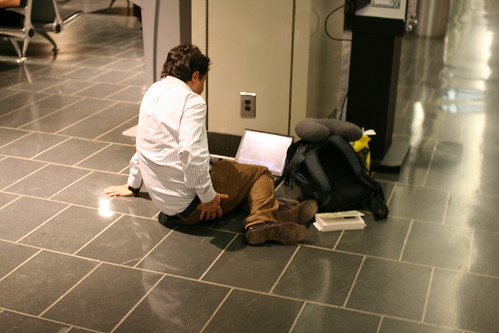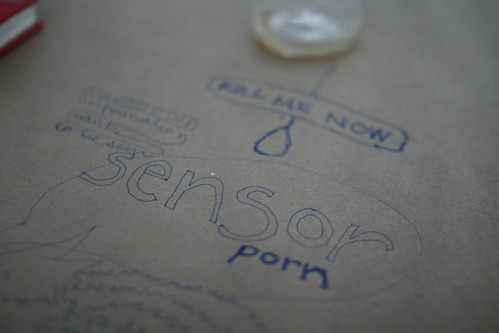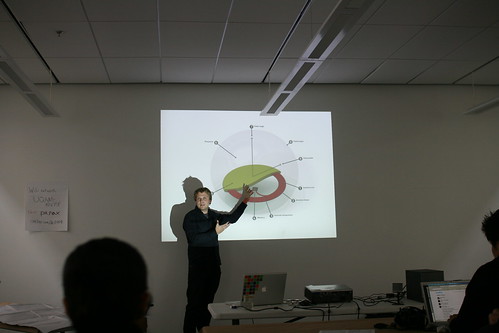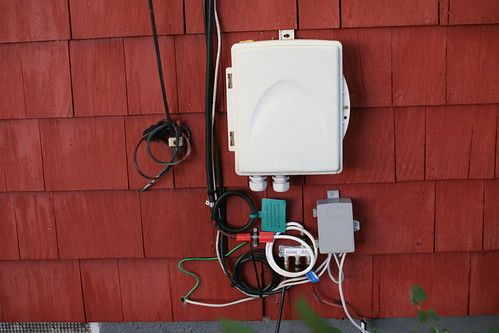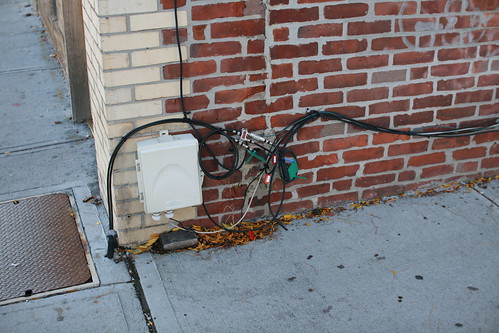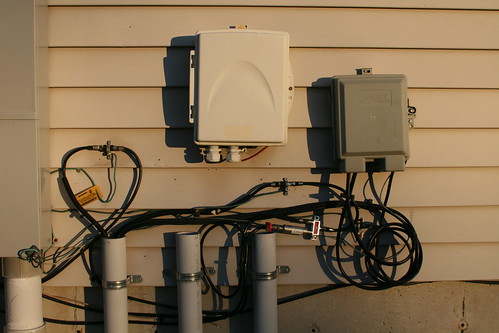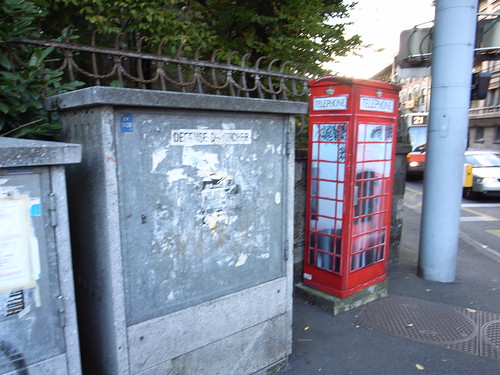In the last issue of Vodafone's receiver, which is about "space", there is an interesting overview of the geospatial web (aka GeoWeb) by Sean Gorman. The article examine how these technologies allow to understand spatial and social phenomena. Starting by a quick overview of the field and how it shifted from cartographers and geo-scientists to hackers and programmers, Gorman describes the different possibilities enabled by such technologies: from mash-up to mobile application (unfortunately using again the sad restaurant-rating example).Why do I blog this? useful material to write a chapter about the history of location-based services. The article by Jonathan Raper is also pertinent as it uncovers principles about what "digital geography" can offer.
Science fiction and HCI/interaction design
Some quick pointers about the relationships between science-fiction and HCI/interaction design: Human Computer Interaction in Science Fiction Movies by Michael Schmitz surveys the different kind of interaction design sci-fi movies envisioned during the past decade. It also interestingly describes how the film technicians made prototype possible and legible.
Make It So: What Interaction Designers can Learn from Science Fiction Interfaces by Nathan Shedroff and Chris Noessel is a nice presentation from SxSW08 that looked at sci-fi material as well as industry future films to show design influences sci-fi and vice versa.
The upcoming paper by Paul Dourish and Genevieve Bell entitled "“Resistance is Futile”: Reading Science Fiction Alongside Ubiquitous Computing that investigates how ubiquitous computing is imagined and brought into alignment with science-fiction culture.
Julian Bleecker's presentation from Design Engaged and SHiFt 2008 also addressed that topic.
A list to be updated I hope.
Flea market electrogear
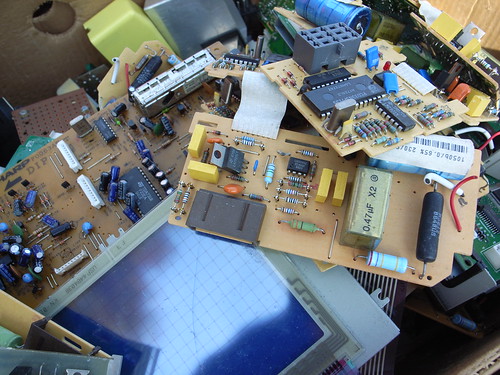 Seen at the flea market last week end in Geneva. It's fascinating to see how such electro-devices are more and more common in this kind of place. Electronic gear used to be common but I see a surge recently in second-hands shops. Why is that intriguing to be blogged? simply because the prominence of electronic artifacts is so important that it starts leaking into more and more places. And the fact that they're not covered with this gloomy black boxes makes it even more curious.
Seen at the flea market last week end in Geneva. It's fascinating to see how such electro-devices are more and more common in this kind of place. Electronic gear used to be common but I see a surge recently in second-hands shops. Why is that intriguing to be blogged? simply because the prominence of electronic artifacts is so important that it starts leaking into more and more places. And the fact that they're not covered with this gloomy black boxes makes it even more curious.
Designing for the mobile and fixed
Found time to sort my notes from last week's workshop. Quick and dirty revision below The first presenter, Alan Dix, nailed down the differences between designing for the mobile and fixed in his "interaction with and through the mobile" speech. He pointed out the main differences: context/device/interaction/infrastructures.
Limited: screen size (if they have screen at all), input, bandwidth, cost connectivity (still today), computational power, heterogeneous platforms BUT opportunities (sensor, camera, projector) Context: variable context (street, meeting, train), focus of interaction (short focused activity, divided attention), interruptions (by mobile devices or mobile task, opportunistic), privacy and security issues, intimacy and availability, ergonomics (movement and vibration when walking/in car, etc.)
Besides, he showed how requirements and evaluation is hard: it's not that you can't do things, it's different. It's particularly hard to do field observation: - distribution of tasks in time and space - may use diary studies - or 'transect' study (loots at people for short time), you only get snippets
And even in the lab because screen capture and device logging may need special toolkits AND it's hard to capture eye gaze etc. hard with device in the air, but holding device on table worse
Heuristics such as Nielsen's are heavily used in UI design but situation is changed with mobile. There are heuristics of mobile UI literature: see Bertini et al. (2007). Appropriating heuristic evaluation methods for mobile computing
May use screen emulator OR "kludge" hardware; what is good enough? Or have 1/2 prototypes (physical input proto but screen on computer with different levels of fidelity)
The second tutorial was by Paul Coulton who gave an insightful overview of the creative capabilities of mobile devices to support original interactions. Paul presented a wide range of interactions using touch/near field communication, the digital camera or location-based scenarios using hands-on examples. I have already blogged about this "exquisite corpse" design rationale which I found intriguing. A slide that struck me as relevant concerning the difference between mobile and fixed computing stated the following:
Opportunities: context (location, presence, sensing), connectivity, feature evolution large demographic, high device penetration, changing fashion Constraints: constrained platforms, fragmentation (difficulty to reach critical mass), porting, distribution (nobody download), low revenues (nobody wants to pay), skills shortage
Why do I blog this? even if it's very raw here (no time to blog lately), I find interesting to describe recent material concerning the difference between fixed and mobile computing.
Electrical switchgear and meters
Recently involved in a design studio concerning electricity and the internet of things at ENSCI design school in Paris, I spent some time these days nailing down the topic of people and energy from various angles: perception and representation of electricity, the importance of infrastructures, the social interactions and practices surrounding electrical objects, etc. Most of the material I employ emerges from my readings (been perusing a lot about the history of techniques and electrical devices design as well as usage lately) and the pictures I take. These pictures come both from various urban safari I make (vacation, on purpose, etc.) as well as user studies. Although I have not studied the topic of electricity per se in my field studies, doing home ethnography allowed me to scratch the surface about these issues and discuss that with informants. We had an interesting discussion today about electrical switchgear and meters. These devices are kind of spot-on of the sort of artifacts I find intriguing to examine. There is indeed a lot to draw from observing them. See for instance the following set of pictures encountered in my recent travels (US - Brazil).
Depending on the culture, switchgear and meters are not located at the same place, and not always "protected". In France for instance, both are generally located close to each other indoor, and, of course, the electrical guy needs to have an appointment with the tenant/owner to check the metering. Whereas in lots of other countries (such as northern america but also in the EU), meters are outdoor. Electrical consumption is then more public and less personal.
Moreover, switchgear are generally indoor. France, again has the habit to refer to the "compteur électrique" has a sort of umbrella term for both the meter and the switchgear (no picture here). This interface with the electrical infrastructure is also more and more complex with lots of red buttons which correspond to an odd mapping of the house/appartment structure, with generally no clear rules.
This last picture, taken last summer in Peru is also very compelling to me as it shows how peruvian house actually reveal the electrical infrastructure from the meter to other house parts with white paint. I don't have any answer for this, my two cents would be that it can be useful for security reasons. In any case, the point of taking and discussing this picture is that is allows to question the environment, find intriguing phenomena and eventually inspire design.
Readers really into that topic might want to have a look at Sliding Friction as well as Jeff Makki's Critical infrastructure walking guide.
About CCTV "impacts"
Reading this report on "the impacts of CCTV in the UK, I was struck by some points in the conclusion:
"crime rates appeared to the authors to be a poor measure of the effectiveness of CCTV. The problem about measuring outcomes in terms of overall crime rates was that they disguised some important successes with particular types of offence. Moreover, in some cases (although not many) an increase in crime was an indicator of success, and this needs carefully teasing out. Similarly, mechanisms increasing recorded crime rates can work alongside those that reducecrime, and these can cancel each other out. Recorded crime rates were subject to a great deal of background noise from other factors, such as other crime reduction initiatives in the areas being studied, regional and national crime trends, and changes in methods of crime recording, any of which could mask the small impact that CCTV might have. (...) there was a lack of realism about what could be expected from CCTV. In short, it was oversold – by successive governments – as the answer (indeed the ‘magic bullet’, Ditton and Short, 1999) to crime problems (...) there was a tendency to put up cameras and expect impressive results, ignoring the challenge of making what is quite a complex measure work (replicating the findings of Ditton et al. 1999), and failing to define what exactly the CCTV system was expected to do. (...) the installation of CCTV requires more than the production of a technically competent system; generally, project designers did reasonably well in this regard. However, systems have to be monitored properly or recordings made and stored properly; but the quality of this work varied considerably from one control room to another."
Why do I blog this? was reading this at the airport after having found the reference in a newspaper, I find interesting the arguments given above as they can also apply to lots of other ubiquitous computing projects. The expectations towards such camera-based system may interestingly apply to other sensor-based deployments. There's a lot more to draw on the report, especially regarding the humans who are in control rooms and who have trouble keeping up with the huge amount of data that is collected.
User acceptance of the smart fridge
The Internet of things field has given, for quite a long time, a prime position to the fridge as the sort of stereotypical device one could "augment". The ubiquity of this artifact, as well as its size and position, made it a good candidate to become the target of ubiquitous computing researchers. The general ideas is often to start from an existing object such as the fridge and try to project if into the future by adding displays, sensors as well as RFID technology. Giving "intelligence" to your fridge often corresponds to add new capabilities allowed by such technologies: internet browsing, fridge content scanning, automatic order over the internet to refill the fridge, etc.
 (picture taken from this BBC article)
(picture taken from this BBC article)
Most of the time, the human aspect of such purposes is left out of the picture as if the fridge designers thought that thing would only requires time to be "accepted". This is why I was interested in Matthias Rothensee's paper entitled "User Acceptance of the Intelligent Fridge: Empirical Results from a Simulation" which he presented at the Internet of Things conference in Zürich few months ago. Although that event seemed scarily engineer/business-based, showing only one side of the coin, there were still some people there who realized that the internet of things is not just some über-cool engineer thing.
The authors employed a smart fridge simulation and a quantitative methodology to study the perception and evaluation of the various assistance functions provided by the system. The variable of interest were: the usefulness, the ease of use, the intention of use and the affective attitude. Some of the results:
"Generally, participants were neutral to positive about the smart fridge. They regarded the system as useful, easy to use, and would slightly tend to use it, if already on the market. Participants estimated their likely reactions to a smart fridge, both, before and after interacting with a simulation of it. Results have shown that despite the fact that the intention to use such a system remains stable after interacting with the simulation, usefulness and affective reactions are negatively affected by interacting with it. This reaction can be interpreted as the participants’ disappointment about the apparent dullness of the smart fridge. (...) usefulness remains the most important predictive variable for the acceptance of the smart fridge, as in traditional workplace technology acceptance literature (...) however, we learned that pleasure felt during interaction with the simulation is also a valuable predictor, underlining the importance of emotion in the acceptance of household technology (...) people’s evaluations differed between the groups, confirming the hypothesis that smart fridge functions are differently appreciated. Nutrition and healthy lifestyle feedback are evaluated most positively, whereas the recipe planer flops."
Why do I blog this? interesting elements here concerning possible users' reactions, especially when considering the low number of user studies which consider the human appreciation of intelligent fridges. However, I am dubious about the use of laboratory tests (and hence the corollary statistical tests) to analyze this kind of design issues. The role of context (spatial, social), practices and habits is very important to analyze regarding acceptance and usage of technologies since these different elements generally have direct or indirect influence on how people employ artifacts.
Spacewar
Steve russell, quoted by Steward Brand, in the legendary Spacewar: Fanatic Life and Symbolic Death Among the Computer Bums published in Rolling Stones in 1972:
"We had this brand new PDP-l, it was the first minicomputer, ridiculously inexpensive for its time. And it was just sitting there. It had a console typewriter that worked right, which was rare, and a paper tape reader and a cathode ray tube display. Somebody had built some little pattern-generating programs which made interesting patterns like a kaleidoscope. Not a very good demonstration. Here was this display that could do all sorts of good things! So we started talking about it, figuring what would be interesting displays. We decided that probably you could make a two-Dimensional maneuvering sort of thing, and decided that naturally the obvious thing to do was spaceships. (...) I had just finished reading Doc Smith's Lensman series. He was some sort of scientist but he wrote this really dashing brand of science fiction. (...) By picking a world which people weren't familiar with, we could alter a number of parameters of the world in the interests of making a good game and of making it possible to get it onto a computer. We made a great deal of compromises from some of our original grand plans in order to make it work well"
Why do I blog this? various intriguing things here: people trying to find applications for the weird new device that sits in their research lab, the importance of talk-and-try, the influence of sci-fi in the researchers' imaginary realms and game design as random tuning. Of course, there is more to draw in the whole piece. Reminds me of some situations, please replace "PDP-l" by whatever technological stuff you have in mind, and "Doc Smith's Lensman" by any cool sci-fi from either the Zeitgeist or the shiny past we never reached and you may encounter a similar situation.
Exquisite mobile
An intriguing design process discussed this afternoon at the MobiKUI workshop: Paul Coulton introduced this basic way to think about mobile sensor-based applications based on the exquisite corpse model: you take 3 dices, throw them and it gives you the design brief: design an application that use the technology (1) in the area (2) for target (3). Paul called it "exquisite mobile".

Why do I blog this? found interesting this method to set yourself design constraints for creating something. Of course the categories can be questioned and modified but it helps to narrow down the application you want to create and can lead to other types of users. We employed it in the afternoon workshop and I expect it to lead people to scenarios different than the stereotypical geotagging or "where's my buddy" proposals.
How design adds to foresight
The relationship between design and foresight has been a recurring interest in the last few years. It interestingly draws some questions such as "can design help futures research?", "can we define foresight as long-range design?", etc. This is why I found interesting the interview of Nathan Shedroff by Nik Baerten from Pantopicon. An excerpt I found relevant regarding to the aforementioned issue:
"Nik Baerten: The fields of foresight, visioning, scenario planning etc. are not unknown to you. You have dealt with future scenarios a few times as well. Could you tell us something about your own experiences? How did you feel design could add to foresight? Furthermore, now as a chair of the design strategy programme, do you see also value in foresight/scenario thinking etc. for design?Nathan Shedroff: Scenario Planning is an incredible tool (...) However, it can be tricky in business because, often, executives “get” the new vision but they’re still left with no way to implement it and alternate scenarios are often purposefully provocative extremes. Taking these visions and weaving them back into present strategy is often too confusing or difficult for managers and leaders to do. Design thinking and processes can be important contributors to the scenario-creating process but just as helpful for this implementation phase. In fact, alternate scenarios that build environments and artifacts can really help executives “see” how these scenarios might affect their business. Design processes bring a culture of brainstorming, critique, prototyping, and testing to the product and service development process. (...) Artifacts from the future that relate directly to an organization’s business can help support courage and commitment to innovation since the tangible attributes of prototypes helps leaders “see” examples of offerings "
Why do I blog this? Reminds me of Raphael's blogpost about the making of a view on the future where he explains how a Nokia Design team worked on making tangible and meaningful the Nokia Category Vision with design & experience concepts for an internal strategy forum. Looking more closely at the underlying design process makes Shedroff's point more clear:
"We started to observe people, not objects or technology. We observed and documented needs & wants, moods & modes, behaviors, social ties, lifestyles (...) spent hours distilling internal and external trend forecast reports, digging and hand-picking ideas from past vision projects, gathering inspiration, and interviewing experts and stakeholders company-wide. (...) Then we discussed. A lot. The often small, and sometimes big moments of everyday life. We built and illustrated moments we believed were the essence of connecting, showing off, working, and exploring. All these moments were consolidated into structured scenarios and storyboards. (...) Then we designed in parallel products, colours & materials, and UIs while continuing scripting and storyboarding the four stories. (...) ideas and designs were shared, evolved and incorporated instantly. (...) Then we went into an iteration and assessment cycle while keeping an eye on the looming deadline. What are we trying to communicate again!? Are the designs telling the right stories? How can we sharpen the message?"
Some great examples here from Nokia about how the design process supports foresight.
Also, when preparing my talk for Design Engaged about failed futures, I often encountered the issue of design and/or foresight: the failures I mentioned could be thought as failed forecasts (e.g. the future is not about a certain endpoint/idea) or failed design (e.g. the future is not about a certain instantiation of an endpoint). One can see products as instantiation of endpoints, which is actually what Chris Heathcote commented on last week. Shedroff's arguments above adds up to the discussion by framing another relationship, or dimension, between design and foresight than the one I discuss in my DE2008 talk.
Nomadic posture
Design Engaged 2008
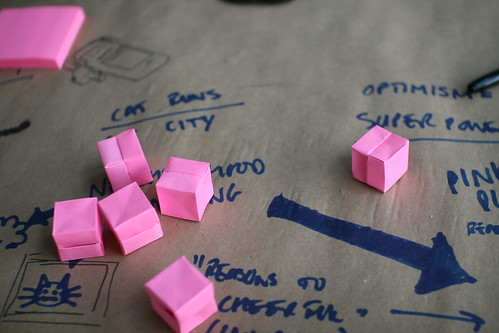 Very good week-end in Montreal at Design Engaged few days ago. Took time to cobble my notes form the whole thing.
Very good week-end in Montreal at Design Engaged few days ago. Took time to cobble my notes form the whole thing.
DE is a designers get-together with a good mixture of practitioners and theorists. The events itself is not a conference nor a workshop but a sort of informal gathering of people who talks (through newcomers presentations), listens, walk in the city (saturday afternoon breaking out groups), eat and sketch (sunday morning use of material collected during the walk). As Andrew Otwell described in his introduction, these activities were meant to support the discussion of "models and visions about the future".
Coming from a sinuous academic background in both hardcore sciences and social sciences, I was kind of intrigued at first by the use of the "model" (by Andrew in his intro and Ben Cerveny in his conclusion). This notion was sort of prevalent over the week end, referring both to models built by designers concerning how they imagine future objects in their ecosystems and meta-models employed by theorists. As Andrew said "designers are constantly making models, that's what the job is, making complete vision of the future" and at the same time other actors (quant in finance) are failing to use their own models to predict the future. The session therefore started around this notion that the "the future wasn't what it used to be", which kind of echoed with my presentation. The "future" seemed also a recurring topic over the week-end with different talks which deal with how we're sort of lost in translation from an epoch with a clear future endpoint to now where the present overflowed the future.
Raphael Grignani started off with a presentation about the Five Dollar Comparison project he and others carry out at Nokia Design. This project explores the relative value of five dollars and consists in a collection of examples from around the world. It takes the form of photos of objects or services that cost the equivalent of $5. Raphael showed some example of what you can get in the world for 5$: goods (foods, hawaianas, beer, BW passport photos, libido enhancers in china, startac phone on ebay), services (motorbike ride). What's maybe more interesting to me here was the discussion of why this has value for Nokia Design: it disrupts processes they have, give crowdsourcing insights, allows alternative funding, enable social responsability (for each picture, submitted to the group, give $5 to a charity), use of creative commons and make peopel realize that doing small things by big numbers has a huge impact.
Ruth Kikin-Gil, a designer who works at Microsoft, gave an insighftul presentation about how and why Strauss and Howe's generation theory are relevant and interesting for design. As she said, it allows to ask questions more than getting answers. She also described how they use generations as personas as well as the different technological framework (personal computers, mobile computing, social networks...) for each generation. That talk led to an interesting discussion of nostalgia and forward-looking attitude exemplified by the following example: 2 geeks talking with each other: one shows his phone to the other: "look! that's what you looked like five seconds ago".
A side comment from Matt Webb on the backchannel was that "designing to meet observed needs reinforces structure and removes its capacity to invent futures", something that I've found interesting as my work is about capturing elements regarding people (be it needs, motivations, contextual insights, etc.). There is indeed a tension between....
The following highlight from from Eric Rodenbeck (Stamen) who talked about gardening and why it's interesting for data visualization. Gardens are strange spaces where life can grow, places where there is not necessarily order but they bring manifest what is important about our future. He sees Stamen's projects as garden: it's not useful but it's delightful, it's cultivate to delight; it's not quite useful, not quite art but "it's a start", which is highly important. What Eric finds interesting is that it's not necessarily articulate but it's there.
Then Kevin Cheng dealt with lazy-generated content, some concepts I was interested in for a foresight project about the Web.
In the afternoon of the first day, near-future laboratory partner Julian talked about "Design Fiction: Something and the Something in the age of the Something". A memorable and insightful discussion which echoed with my own presentation.
Starting by interrogating the representation of the future, he questioned how we imagine what can come to be, what are the ways the futures will be and how these elements shape what we consider reasonable and possible futures. Change is often seen as inevitable and a linear model as if there were always one sort of alternative. In addition, "the future is here, it's just not evenly distributed" from William Gibson led to the "sandwich spread representation of the future": the representation of the future is lumpy in bits dans doesn't get to everyone evenly. Some people receive the future more than other, some try weird things to "live in the future" and it's hard to explain to parents, siblings, etc. One of the slides interestingly referred to possible quotes by Bruno Latour ("...") to show the 3D linkages of human/non-human collectives representation of the future, another important aspect Julian brought to the table. What he meant is simply that complex knots and linkages between many disparate social practices create thick representations of human activities, including our projections and imaginations about the future.
The second part of his talk was about ubiquitous computing is related to science-fiction, based on a forthcoming paper by Paul Dourish and Genevieve Bell. For instance if you type "minority report interface" in google you get some links about engineers, scientists, etc. It shows the entanglement between what people do in laboratory and steven spielberg's team, this slippery zone that reveals the blurriness between scifi and ubicomp... a promising area to explore. Lots of sci-fi pieces put together to fashion a perspective that tell a story about ubiquitous computing-y things as they are projected into sci-fi narratives. However, as Julian expressed, Ubicomp is Sci-Fi since it use sci-fi as a reference point for engineers and scientists in the lab. In the end, what we have is the deployment of an idea-mass 3D Latourian representation of the future: conversations shaped by human and non-human objects, their circulation which eventually draw more agents.
The last part of his talk concerned the importance of props and prototypes, which can take 2 forms: in their canonical form (the kind of stuff you build, scaffolding around ideas) OR David A. Kirby's diegetic prototypes (how prototypes and narrative ones shape an influence). The latter was described with the following quote from the RHCP: "space may be the final frontiers, but it's made in a Hollywood basement" (Californication, 1999!): being able to make the things and wrap them into a narrative form. To some extent, prototypes/props are idea-mass: they are objects that have attractive forces, enroll people and design can also be a kind of fiction making: design-fiction. In other words, stories matter when designing the future and perhaps even more than the "real thing". Julian then sees design as speculative prototyping, things that are real scifi, really curious and orthogonal to the conventions of technology-market-economies. And the measure of success is when someone says "stupidest fucking idea EVER" (jonah brucker-cohen).
He concluded on these 5 points:
- objects tell stories for people, not scenarios for users
- there are many futures, no inevitabilities
- makes lots of stuff quickly
- assume weird (or no) market models, weird imaginary worlds
- assume you are from the future
His talk obviously gave a great framework for Anab Jain's talk, as if her beautiful projects (Yellow Chair, the Gubbins as well as this awfully nice map powered by sugar which starts dying) were perfect examples of what Julian just said. I am looking forward to read this "Objects incog" book from the project she did with Alex Taylor ("Life and Death in Energy Autonomous Devices"). I particularly love the notion of aging objects and decay as a mean to show that death is very close, and it's acknowledged by the user, trying to figure out what it means. Mouna Andraos's "From craft to designing experiences" work and Tuur Van Balen's "My city = my body" also fitted very well in the picture.
After my talk, Molly Wright-Steenson spoke about the "anterior future" (the french tense) and some enquiries about past versions of the future ("how old are our futures? where did our futures comes from?"). It's always intriguing to nail down the obscure french authors Molly is using in her theoretical work. People such as Etienne-Louis Boullée for instance. Surely some food for thoughts to integrate to my own thinking about failed futures.
From Aaron Cope's talk about sensor porn. I liked his way to figure out what happen when the system breaks and how what that means the common perception is that we will just adapt. I now keep in mind the two following quotes he referred to and that I found insightful:
" We should be mapping information that in some ways has been historically un-mappable because it is 1) not valued or is 2) actively seen as threatening or is 3) simply too hard to map using traditional GIS" Anselm Hook
"It is this narrow definition of context that makes life harder for ourselves, because adding more and more sensor readings is not really the same thing as adding more and more context" Dawns Nafus
I loved Russell "i do this sort of project that involves printing the internet out" Davies as well as Schulze and Webb's presentation but at that specific moment, I stopped taking notes, enjoying the whole show ;) Both presentations were insightful
Timo Arnall's presentation about "visible present branded" was also interesting to me both because I am interested in the topic and as an example of cutting edge digital design practice. Starting form Dourish and Bell's characterization of uibcomp, Timo introduced his interest towards RFID objects as building blocks of ubiquitous computing: they are highly designed and visible, branded and it's stuff not that emerges only from engineering.
The first point Timo made was to show the importance of visibility/invisibility of interactions. Some examples: Hertzian tales by Anthony Dunne (invisible radiowaves leaking out people's houses into public space) + semiconducor that represent electromagnetic fields as very visual, hairy and unstable, sort of artistic interpretation of how fields behave ("from a viz POV it's beautiful, put images in my head") + the bubbles of radio (characterized radio fields through visual characters).
From a pragmatic perspective, timo is interested by invisible affordances of things, he and his colleagues worked on a rigorous analysis of how we signify/flag up different aspects of ubicomp, also worked on icons, to expose what is invisible. The invisibility can be a confusing model, a limiting model for ubicomp. What is happening is that things always become visualized; when sensors emerges into space you see "do this do that" (tap sensor). He looked at signage related to wireless: often represented as 3 concentric rings... interesting from the visual design perspective: when points up: positive, when points down or lateral: security. Looking at the visual vernacular of RFID allows to understand how it is represented. This is beginning to affect the ways we interact with things: the gestures people used to swipe cards, intimacy of touching phones for rfid contacts. Their next step is to sketch out what fields do, what material, what properties, represent field lines but these viz do not necessarily give way to tell how to interact with technologies!
Using an "RFID pen" that draws when it detects an RFID signals, they made a 3D picture of an RFID field viz of the actual readable volume around a coiled RFID antenna. It's an experiment in field drawing: as shown on this video. The en result is an interesting shape with properties. What are the implications? it's good to have a model but even more interesting to see what that means for interaction:
- different feeling of interactions depending on how close the tag is to the reader
- the physical object can interact + or - with the field
- different shapes of the rfid reader can be analyzed and producted... use it as an idea generation
- investigate how the field (which surround the device) is a material for interaction
tool... like tag rader in a shape of a bowl, a sniffing dog that snifs objects
The purpose now for Timo and his colleagues is to turn an engineer-based technology in sth designers can look at, turn RFID into sth that has clear affordances for design as represented on the pic above: presence, memory, internal connections, antenna shape, antenna size, enclosure, field range, field width, field width. These are the important thing for designers to work with. I really enjoyed both that slide and the methodology they dealt with to come up with this list of affordance, there's really something innovative here. Simply, it's beyond lots of research I've seen in ubicomp papers and the perspective/tools they employed allowed them to (1) ask new questions, (2) come up with an interesting set of answers.
Ben Cerveny' conclusion about "Flocking through utopias" was a nice endpoint for DE. Ben showed how an event such as Design Engaged can be seen as "team sport, a self-organized school, collaboratively browsed" which allows to explore the space, like a cultural exchange. This "social club" would then have the following characteristics:
- discontinuity: it turns things are falling apart, critical moment... at the same time, other people (quants) works on developing model (viz, metaphor) for the future. that team did not won the medal this year because of that, there are some things that need reforming, DE as a group can provide new models
- optimism: there is no shiva in the west; when things fall apart in the west, this is bad however if things don't fall apart, that's death; if a system is not changing, it's over complexity, emergence happens in growth/decay cycles so we have to embrace decay
- possibility surfers, playing with models/possibilities, step out into the meta, look where value is going
- use the ultimate social object: utopia: how to build community around utopias, grand projects
- what we do is a game of system models with prototypes from alternative universes, they're not from the future, but they propose new set of design, bring probes from that space: ultimately, it allows to build a very large model
Surely a great event with a wide set of perspective. I particularly liked the mix of perspectives ranging from presentations of design projects, theoretical presentations and pragmatic views. Thanks Andrew, Boris, Jennifer and Mouna for the invitation and setting this up. My take away of the event below.
Uncanny valley variability
 Which part of this bear encountered yesterday at MIT Medialab is close to the Uncanny Valley? The bear-head-shaped face? The way it looks down? the fur-like body parts? or the explosive body wiring? Is the furry part more uncanny than the head?
Which part of this bear encountered yesterday at MIT Medialab is close to the Uncanny Valley? The bear-head-shaped face? The way it looks down? the fur-like body parts? or the explosive body wiring? Is the furry part more uncanny than the head?
Household cable wiring
tangible@home
Quick talk at MIT Medialab this afternoon, during the "tangible interfaces" course of Hiroshi Ishii. It's called "Tangible@home". The presentation is a very brief overview of the work I am pursuing in terms of UX research. After a quick description of the devices I am interested in and methods I use (mostly ethnography-inspired), I described 5 research issues or usage patterns.
Thanks J*B for the invitation.
Game controllers evolution and game design
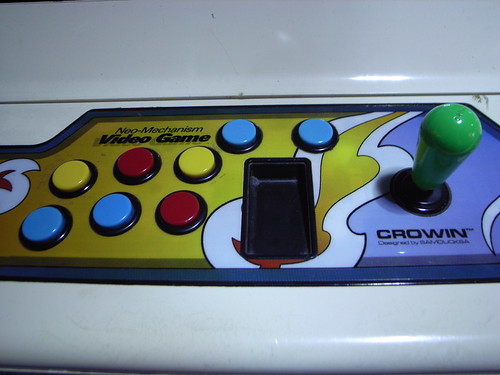 In "The Evolution of Game Controllers and Control Schemes and their Effect on their games", Alastair H. Cummings interestingly traces the history of video-game controllers. A good read in conjunction with my earlier post about this very topic. What is relevant in that paper is the second part of the issue: how the evolutions of game controller schemes is reflected in the game play, what is the mutual relationship between both. See for example:
In "The Evolution of Game Controllers and Control Schemes and their Effect on their games", Alastair H. Cummings interestingly traces the history of video-game controllers. A good read in conjunction with my earlier post about this very topic. What is relevant in that paper is the second part of the issue: how the evolutions of game controller schemes is reflected in the game play, what is the mutual relationship between both. See for example:
"The first controllers were made of whatever was available to the scientists in their electronics labs and the games were equally simple. Highly simplified versions of sporting activities such as table tennis, shooting galleries and space shooters. With the creation of the gamepad games became more complicated. Games didn’t have to be simple concepts, although the gameplay was still limited by the computing power of the era. 2D platform games took players on long journeys with them in control of simple movement of their characters. With 3D came the analogue stick, providing players with a way to guide their characters around their new 3D environment. The latest consoles let players perform the actions that they want their characters to perform and they can become part of the game more than ever before. (...) Finally there is the purely functional purpose of the PC control schemes. Whilst reflecting little on the actual actions taken in the game, the simple control schemes can become second nature to players, to give them a feeling of immersion on par with the best novelty controller. Despite this it can be seen that there has been minimal development on new types of games on the PC, these control schemes work, and so these games are the only ones that will be played."
Why do I blog this? interesting material for current project about tangible interfaces. There would be something to write about the evolution of game controllers, which were the forces that shaped them and how it influenced the whole game design. This paper only begin to deal this issue and I'd find intriguing to know how the schemes had been chosen and discussed by a broad range of actors (developers, game designers, etc.) in the design process per se. From my experience, I realized how much power developers in game studio had on the Wii controllers scheme decision, simply because some game designers were not really able to understand how the device worked. Things used to be different with old-school pads.
welcoming a new device
When attributes of a city are transfered in another
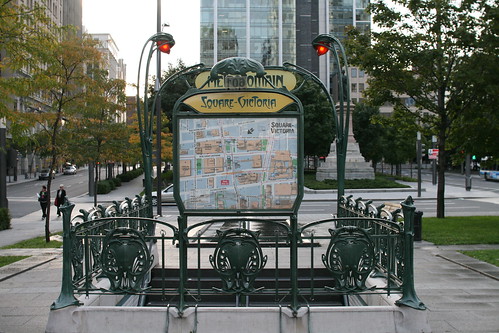 An interesting pattern I've found here last week during my ventures in contemporary cities: when attribute of a city are transfered in another.
An interesting pattern I've found here last week during my ventures in contemporary cities: when attribute of a city are transfered in another.
2 examples: the one above shows the famous entrance to the Paris subway system by Hector Guimard. Except that this nice organic and artnouveau artifact is located in Montreal and not in Paris. In this case, it was actually given by RATP (the parisian transport company) to the Montreal metro in 1967, made out pieces of demolished Guimards from Paris metro stations.
The second example is simply this street box that contains electrical and phone wiring on the streets of Geneva: it has basically been wrapped with something that makes it look like a badly-ripped off from the red telephone box designed by Sir Giles Gilbert Scott.
Why do I blog this? curiously observing the meme-like transfer of shapes/colors of items from one city to another. Perhaps this is a representation of post-modernity.
buildings as flows and process
Each time I go to north america, I am struck by how infrastructures are more apparent than in continental europe (= home). Pipes, tubes, sprinklers look simply more present to me, perhaps because they're made more visible through colorful signage.
See for example this gas tubes in Montreal:
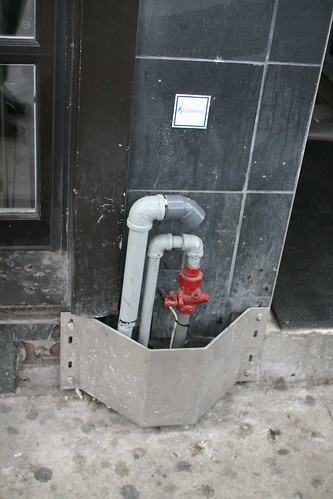
Or these nice tubes on a wall:

This lovely yellow tube to refuel indoor heating systems is also stunning:
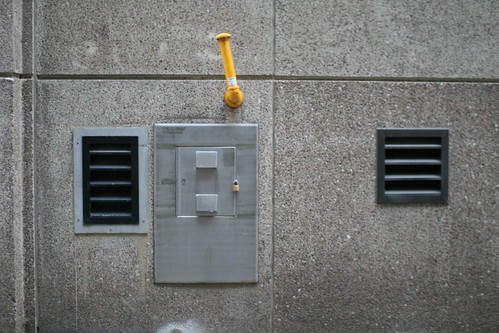
A favorite in MTL is the "siamoises", these dual sprinklers which often comes with this intriguing signs (way up because it needs to be visible when there is snow):
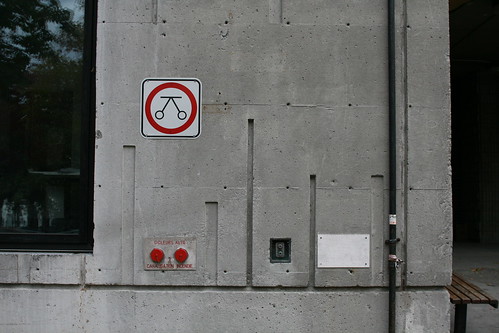
Another favorite is certainly this kind of huge tape in san diego:
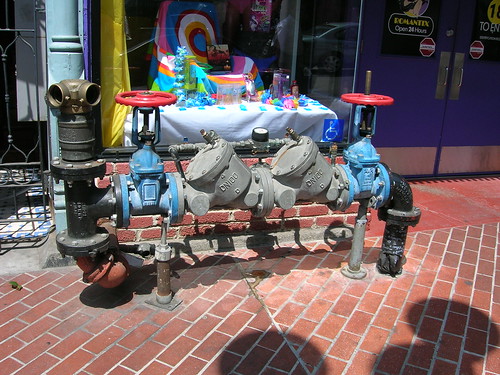
Why do I blog this? simply this helps to frame and understand the large technical systems of our urban environments. What I find interesting here in this made-visible process is the fact that it reflects how buildings are "process" with flows coming in and flows coming out.
think before you tag
 First comment, it can be understood as "tag" in the graffiti sense but also in the geotag meaning (i.e. linking content such as text/music/pictures to geographical data). Although it's not a common practice in cities, it's intriguing to see such warning from a possible near future. I'm not sure geotagging will spread but I find pertinent to see how creating such warning include that technology-mediated practice in a sort of "design fiction" narrative: it actually reveals the possibilities and let people (who understands it), wonder about what can be the proper usage.
First comment, it can be understood as "tag" in the graffiti sense but also in the geotag meaning (i.e. linking content such as text/music/pictures to geographical data). Although it's not a common practice in cities, it's intriguing to see such warning from a possible near future. I'm not sure geotagging will spread but I find pertinent to see how creating such warning include that technology-mediated practice in a sort of "design fiction" narrative: it actually reveals the possibilities and let people (who understands it), wonder about what can be the proper usage.
Second comment, as Timo would say: "it's also serif font on a black background".




